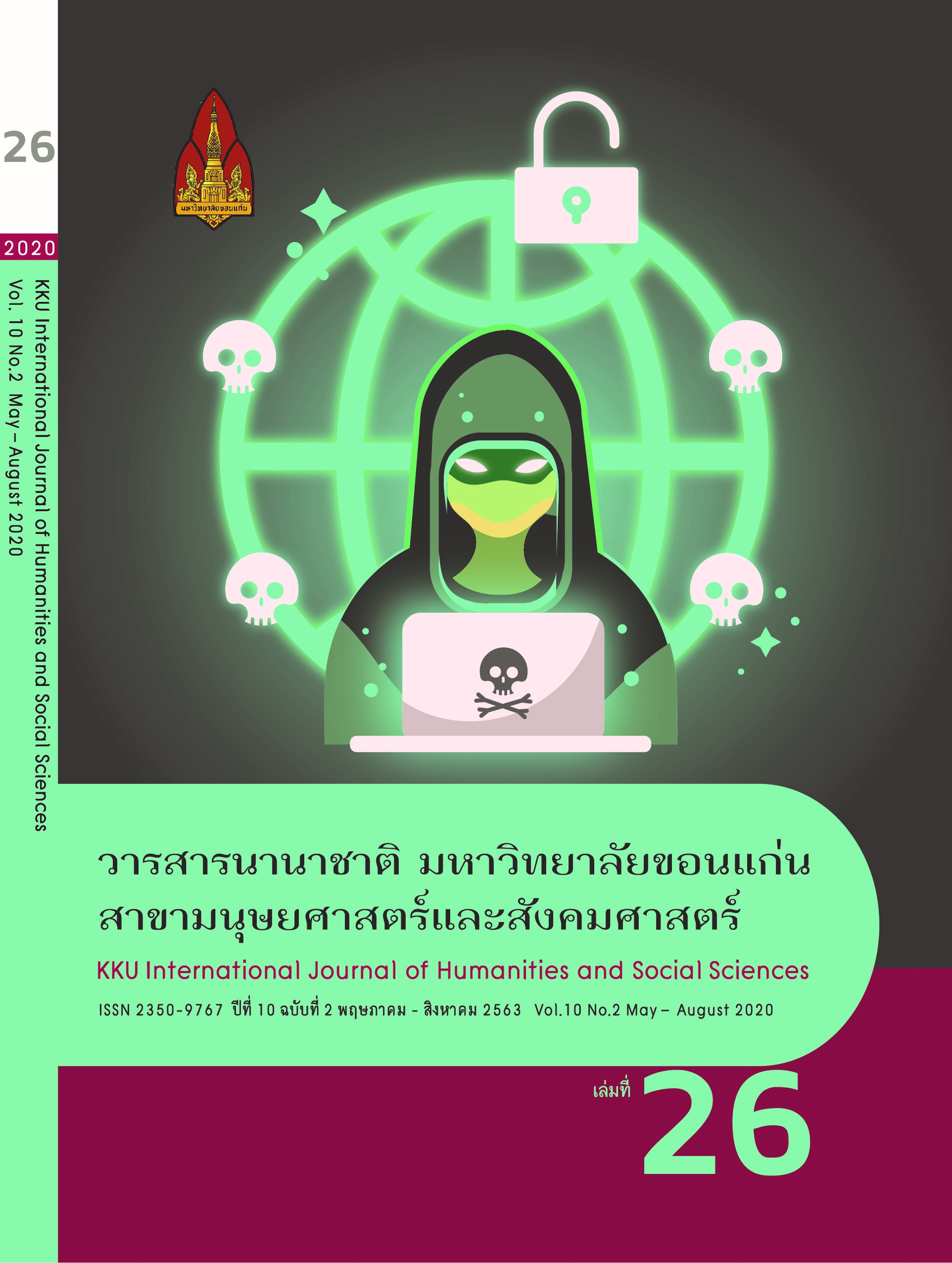International Migration Policy of Foreign Workers: A Case Study of Immigration and Employment in Taiwan
Main Article Content
Abstract
Foreign workers are part of the Taiwan’s labour market since 1992 as there is international migration policy of foreign workers. In this research paper, a researcher determined to learn and understand the international migration policy of foreign workers for immigration and employment into Taiwan’s labour market. The main objective of this study is to analysis foreign worker migration policy of Taiwan’s labour market in term of immigration and employment as the macro level unit of analysis on destination country. The study indicated that Taiwan government relies on control tools of demand-driven system for immigration and employment the foreign workers into labour market both skilled foreign workers in primary labour market and unskilled or semi-skilled in secondary labour market, which the employers request the right to immigrant and employ foreign workers for the government However, labour demand of employers in the micro level is under the conditions of the macro level on the national interest. In addition to skilled foreign workers, Taiwan also relied on less control tools of demand-driven system for immigration and employment among skilled foreign workers to attract foreign workers to perform in its labour market. Thus, Thai government should develop foreign worker migration policy for immigration and employing under demand-driven system systematically in particular primary labour marker for skilled foreign workers, in order to attract skilled foreign workers as a human capital in Thailand's knowledge base for economic development.
Article Details
References
ดุษฎี อายุวัฒน์, สุกัญญา เอมอิ่มธรรม และอภิศักดิ์ ธีระวิสิษฐ์. (2553). วิถีชีวิตแรงงานไทยในไต้หวัน: กรณีศึกษาในถิ่นปลายทาง. มนุษยศาสตร์สังคมศาสตร์ มหาวิทยาลัยขอนแก่น, 27(1), 1-28.
นิมนตรา ศรีเสน. (2562). การเคลื่อนย้ายของแรงงานไทยกับสภาวะผิดกฎหมายในเกาหลีใต้. วารสารสังคมศาสตร์ มหาวิทยาลัยเชียงใหม่, 31(1), 145-170.
ภัทร สมันตรัฐ. (2560). แรงงานไทยในมาเลเซีย: สภาพการจ้างงานการคุ้มครองแรงงานและแรงงานบังคับ. เอเชียปริทัศน์, 38(1), 78-101.
มะดาโอะ ปูเตะ และเภาซัน เจ๊ะแว. (2554). การเดินทางของแรงงานมลายูมุสลิมจากจังหวัดชายแดนภาคใต้ของประเทศไทยเข้าไปทำงานในรัฐทางตอนเหนือของมาเลเซีย. วารสารวิชาการอัลฮิกมะอุ มหาวิทยาลัยอิสลามยะลา, 1(1), 13-21.
วรรณา ก้องพลานนท์. (2559). สภาพปัญหาและการปรับตัวด้านวัฒนธรรมของแรงงานไทยย้ายถิ่นรัฐปีนังประเทศมาเลเซีย. วารสารมนุษยศาสตร์และสังคมศาสตร์ มหาวิทยาลัยทักษิณ, 10(2), 89-105.
สุทธิพร บุญมาก. (2562). นโยบายการย้ายถิ่นระหว่างประเทศของแรงงานชาวต่างชาติระดับทักษะ: กรณีศึกษาการเข้าเมืองและว่าจ้างงานของประเทศมาเลเซีย. MFU Connexion, 8(1): 258-299. doi: 10.14456/connexion.2019.8
สุทธิพร บุญมาก และมูหำหมัด สาแลบิง. (2560). การเคลื่อนย้ายแรงงานไทยเชื้อสายมลายูระดับทักษะจากจังหวัดชายแดนภาคใต้สู่ประเทศมาเลเซีย. วารสารราชพฤกษ์, 15(2), 1-8.
สุทธิพร บุญมาก. (2556). การส่งเงินกลับบ้าน: แรงงานไทยเชื้อสายมลายูในประเทศมาเลเซีย. วารสารปาริชาต มหาวิทยาลัยทักษิณ, 26(1), 75-93.
สุทิน สายสงวน. (2553). การย้ายถิ่นแรงงานข้ามชาติ: แรงงานไทยในญี่ปุ่นกับแรงงานญี่ปุ่นในไทย. วารสารญี่ปุ่นศึกษา, 25(2), 51-66.
Castles, S., & Miller, M. J. (2003) The age of migration: International population movements in the modern world. 3rd edition, New York: Palgrave Macmillan.
Chomchai, P. (2000). Thai Migrant Labour in Brunei: Cause of Migration and Socio-Economic Impact. in S. Chantavanich, A. Germershausen and A. Beesey (Eds.), Thai Migrant Workers in East and Southeast Asia 1996-1997 (pp.108-126). Bangkok: Asian Research Center for Migration, Institute of Asian Studies, Chulalongkorn University.
Chunjitkaruna, P. (2000). Pitfalls and Problems in Search for a Better Life: Thai Migrant Workers in Japan. in S. Chantavanich, A. Germershausen and A. Beesey (Eds.), Thai Migrant Workers in East and Southeast Asia 1996-1997 (pp.246-271). Bangkok: Asian Research Center for Migration, Institute of Asian Studies, Chulalongkorn University.
Harrison, B., & Sum, A. (1979). The Theory of "Dual" or Segmented Labor Markets. Journal of Economic Issues, 13(3), 687-706. Retrieved from www.jstor.org/stable/4224841
Hewison, K. (2004). Thai Migrant Workers in Hong Kong. Journal of Contemporary Asia, 34(3), 318-335.
ILO International Migration Programme and Subregional Office for East Asia. (2005). Labour migration policy and management: Training materials. Bangkok: International Labour Organization.
Iredale, R. (2001) The migration of professionals: Theories and typologies. International Migration, 39(5), 7-24.
Kang, S. D. (2000). Thai Migrant Workers in South Korea. in S. Chantavanich, A. Germershausen and A. Beesey (Eds.), Thai Migrant Workers in East and Southeast Asia, 1996-1997 (pp.210-235). Bangkok: Asian Research Center for Migration, Institute of Asian Studies, Chulalongkorn University.
Kitiarsa, P. (2006). Village Transnationalism: Transborder Identities among Thai-Isam Migrant Workers in Singapore. Working Paper No. 71 Asia Research Institute, National University of Singapore.
Laodumrongchai, S. (2000). Thai Migrant Workers in Taiwan. in S. Chantavanich, A. Germershausen and A. Beesey (Eds.), Thai Migrant Workers in East and Southeast Asian, 1996-1997 (pp.159-176). Bangkok: Asian Research Center for Migration, Institute of Asian Studies, Chulalongkorn University.
Lowell, L. (2001). Policy Responses to the international mobility of skilled labour. Geneva: International Labour Office https://www.ilo.org/wcmsp5/groups/public/---ed_protect/---protrav/---migrant/documents/publication/wcms_201774.pdf
Massey, D., Arango, J., Hugo, G., Kouaouci, A., Pellegrino, A., & Taylor, J. (1993). Theories of International Migration: A Review and Appraisal. Population and Development Review, 19(3), 431-466. doi:10.2307/2938462
Ministry of Labour Republic of China (Taiwan) (2019). Foreign workers update 2019/11/20 National Statistics of Taiwan http://statdb.mol.gov.tw/html/mon/i0120020620e.htm
Nagayama, T. (2000). Thai Migrant Workers in Japan. in S. Chantavanich, A. Germershausen and A. Beesey (Eds.), Thai Migrant Workers in East and Southeast Asia, 1996-1997 (pp.236-245). Bangkok: Asian Research Center for Migration, Institute of Asian Studies, Chulalongkorn University.
National Statistics of Taiwan (2019). Statistics from Statistical Bureau Latest indicated https://eng.stat.gov.tw/point.asp?index=9
Piore, M. J. (1979). Birds of passage: migrant labor and industrial societies. Cambridge: Cambridge University Press.
Ruenkaew, P. (2002). Female Thai Migrant in Japan. Journal of Gender studies, 5(22), 47-69.
Sek-hong, N. & Lee, G. (2000). Thai Migrant Workers in Hong Kong. in S. Chantavanich, A. Germershausen and A. Beesey (Eds.), Thai Migrant Workers in East and Southeast Asia, 1996-1997. Bangkok: Asian Research Center for Migration, Institute of Asian Studies, Chulalongkorn University.
Suriya, S. & Kitiarsa, P. (2005). Surviving in the Marginal World: Life and Community of Thai Migrant Workers in Japan. in S. Suriya and P. Kitiarsa (Eds.), Thai Social Force in the Next Decade: a real Alternative?, Nakhon Ratchasima, Institute of Social Technology, Suranaree University of Technology.
Tsay, C-L. (2002). Labour Migration and Regional Change in East Asia: Outflows of Thai Workers to Taiwan. Paper presented to the Southeast Asia's Population in a Changing Asian Context, Bangkok: Siam City Hotel, 10-13 June 2002.
Wong, D. (2000). Men who Built Singapore: Thai Workers in the Construction Industry. in S. Chantavanich, A. Germershausen and A. Beesey (Eds.), Thai Migrant Workers in East and Southeast Asia, 1996-1997 (pp.58-107). Bangkok: Asian Research Center for Migration, Institute of Asian Studies, Chulalongkorn University.


